Triggerfish
Family Balistidae
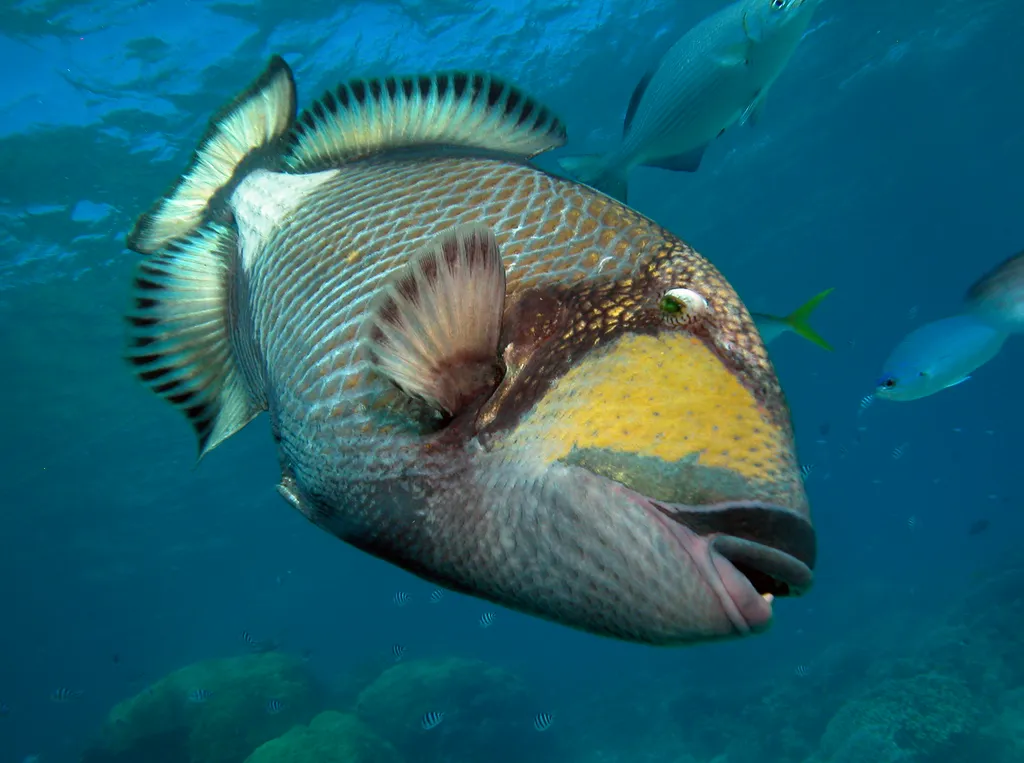
Photo by Leonard Low from Australia / CC BY 2.0 via Wikimedia Commons
Triggerfish (Balistidae) are the "engineers" and "bouncers" of the reef. Named for their unique locking dorsal spine, they can wedge themselves into crevices so tightly that no predator can pull them out. While many species like the Picasso Triggerfish are painted living art, the family is infamous for the Titan Triggerfish—a highly territorial giant that fears nothing, not even divers. With powerful jaws designed to crush crabs and sea urchins, they are intelligent, industrious, and sometimes a bit too grumpy for their own good.
🔬Classification
📏Physical Features
🌊Habitat Info
⚠️Safety & Conservation
Identification Guide
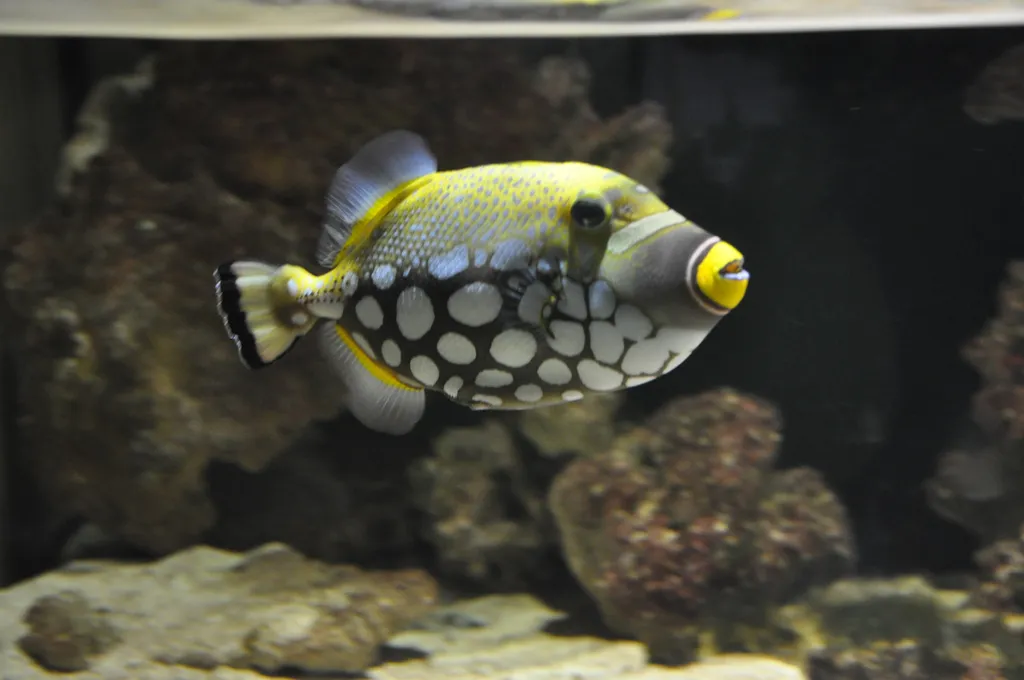
Photo by shankar s. from sharjah / CC BY 2.0 via Wikimedia Commons
Field marks:
- The "Trigger": First dorsal spine is long and stout; it can be locked upright by a second, smaller "trigger" spine.
- Shape: Deep, laterally compressed body (oval or diamond-shaped).
- Swimming: Uses dorsal and anal fins to undulate (balistiform swimming); tail is used for bursts of speed.
- Eyes: Set high and far back on the head, moving independently.
- Mouth: Small but strong mouth with chisel-like teeth.
Differences from Similar Species
- Filefish (Monacanthidae): Have a single long dorsal spine that cannot be mechanically locked; body is flatter and skin is rougher (sandpaper-like). Triggerfish skin feels like tough leather armor.
- Pufferfish: Rounder, no locking spine, and swim more clumsily.
- Surgeonfish: Have a scalpel-like spine on the tail, not on the back.
Juvenile vs. Adult
Juveniles are often shy, hiding in rubble or floating with debris. Adults are bold and patrol open reef areas. Some juveniles (like the Clown Triggerfish) have even more striking spots than adults.
Top 10 Fun Facts about Triggerfish
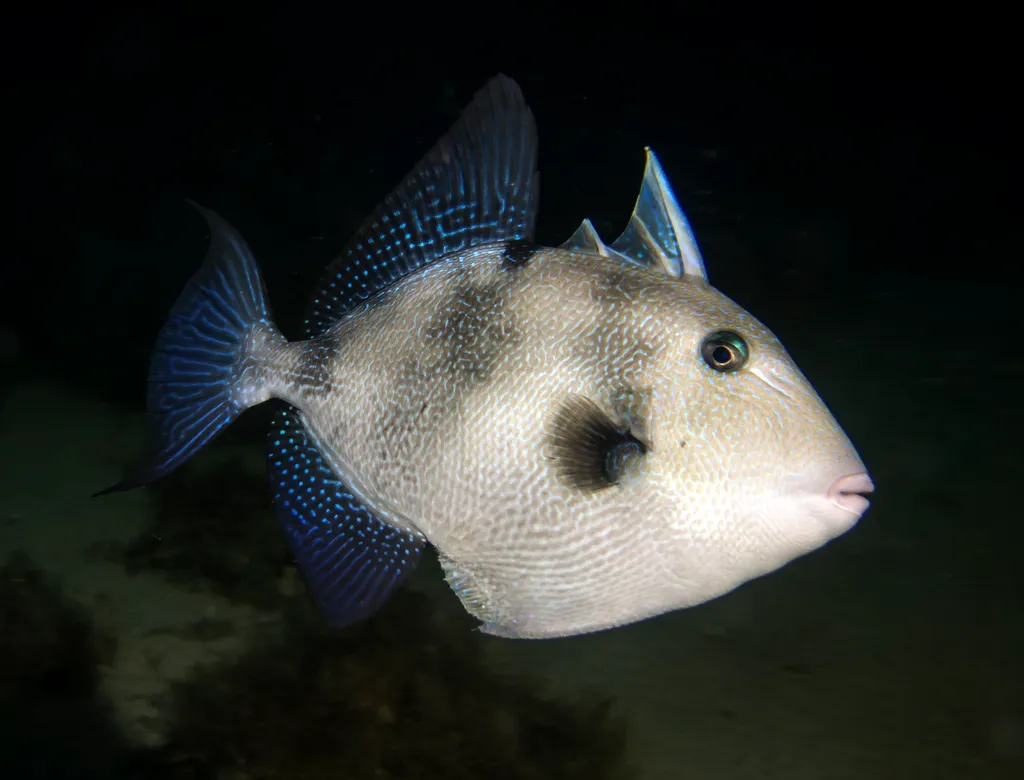
Photo by BusuttilV / CC BY-SA 4.0 via Wikimedia Commons
1. The Locking Mechanism
The "Trigger" isn't just a name; it's a mechanical marvel. The first spine is locked in place by the second spine. If you push the first spine down, it won't budge (and might break). But if you depress the second spine (the trigger), the first one unlocks and folds down instantly. It’s nature’s safety lock.
2. The "Cone of Death"
Nesting Titan Triggerfish are the terror of divers. They defend a territory shaped like an inverted cone extending from their nest to the surface. If you swim over them, you are in the danger zone. The only escape is to swim horizontally away, not up (swimming up keeps you in the cone).
3. Underwater Bulldozers
Triggerfish are industrious workers. To find food buried in the sand, they blast water from their mouths to uncover crabs and worms. They also pick up large chunks of coral rubble with their mouths and toss them aside, literally rearranging the reef landscape.
4. The "Picasso" of the Sea
The Lagoon Triggerfish (or Picasso Triggerfish) is the state fish of Hawaii, known locally as Humuhumunukunukuapua'a (try saying that three times fast!). It means "triggerfish with a snout like a pig," referring to the grunting noise they make when stressed.
5. Sleeping on Their Side
At night, triggerfish wedge themselves into a hole and lock their spine to stay put. But here's the weird part: they often sleep lying on their side. Divers often think they are dead, but they’re just having a good snooze.
6. Shell Crushers
Their teeth are incredibly strong. They can bite through the spines of sea urchins, flip them over, and attack the soft underbelly. They also crunch through crab shells and clams as if they were potato chips.
7. Intelligent Eyes
Triggerfish are considered highly intelligent. Their eyes move independently, and they often rotate to look directly at a diver. It feels like they are calculating your threat level—and they probably are.
8. The "Red-Toothed" Swimmer
The Red-toothed Triggerfish is unique. It’s deep blue/purple, has vampire-like red teeth, and swims in large schools in the open water feeding on plankton—very different from its benthic, solitary cousins.
9. Armor Plating
Their scales are large, diamond-shaped, and tough as nails. This "chainmail" armor protects them from sharp coral and the spines of their prey. It’s so tough that in the past, dried triggerfish skin was used as a rough file.
10. Grumpy Gardeners
By constantly excavating sand and moving rocks, they aerate the substrate and expose prey for other smaller fish (who often follow them around). They are the grumpy, unintentional providers of the reef.
Diving & Observation Notes
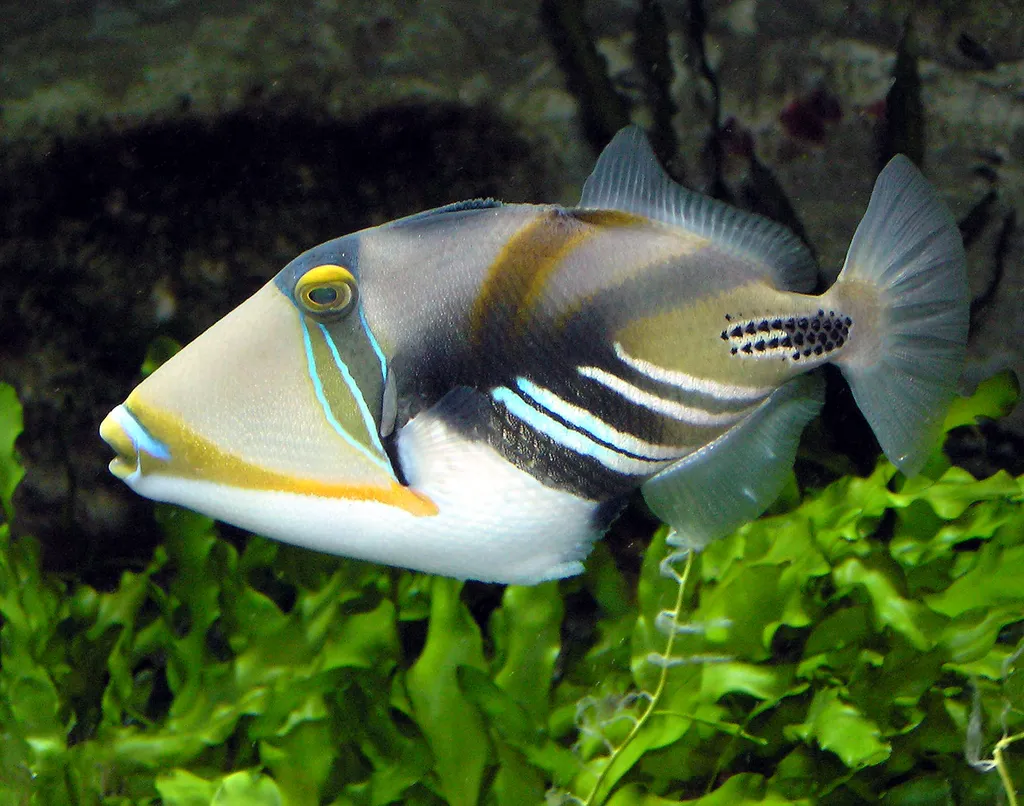
Photo by Arpingstone via Wikimedia Commons
🧭 Finding Triggerfish
Look for the colorful Picasso Triggerfish in shallow lagoons. Scan the reef slope for the massive Titan Triggerfish moving rocks. Look up in the blue for schools of Red-toothed Triggerfish fluttering their fins.
🤿 Approach & Behavior
- The Titan Warning: If a Titan Triggerfish raises its dorsal spine, turns on its side to look at you, or swims directly at you—BACK OFF.
- Respect the Nest: If you see a large crater in the sand with a triggerfish hovering over it, that's a nest. Go around it, wide.
- Fins as Barrier: If attacked, put your fins between you and the fish. Their bite can go through a wetsuit and take a chunk out of a fin.
📸 Photo Tips
- Keep Distance: Use a longer focal length for Titans. Do not get in their face with a wide-angle unless you want a bite mark on your dome port.
- Patterns: The Picasso and Clown Triggerfish have incredible geometric patterns perfect for side-profile shots.
- Teeth: Try to capture the Red-toothed Triggerfish's smile—it’s spooky and cool.
⚠️ Ethics & Safety
- Do Not Feed: They can become aggressive if they associate divers with food.
- Don't Test the Trigger: Never try to manually depress the spine of a live fish. It stresses them out and you might get bitten.
🌏 Local Guide Nuggets
- Koh Tao (Thailand): Famous for its aggressive Titans at "Green Rock" and "Chumphon Pinnacle". They are practically local celebrities (and villains).
- Maldives: Huge schools of Red-toothed Triggerfish darken the water at some drop-offs.
- Red Sea: The Blue Triggerfish here are abundant and tend to be less aggressive than their Pacific Titan cousins.
Best Places to Dive with Triggerfish
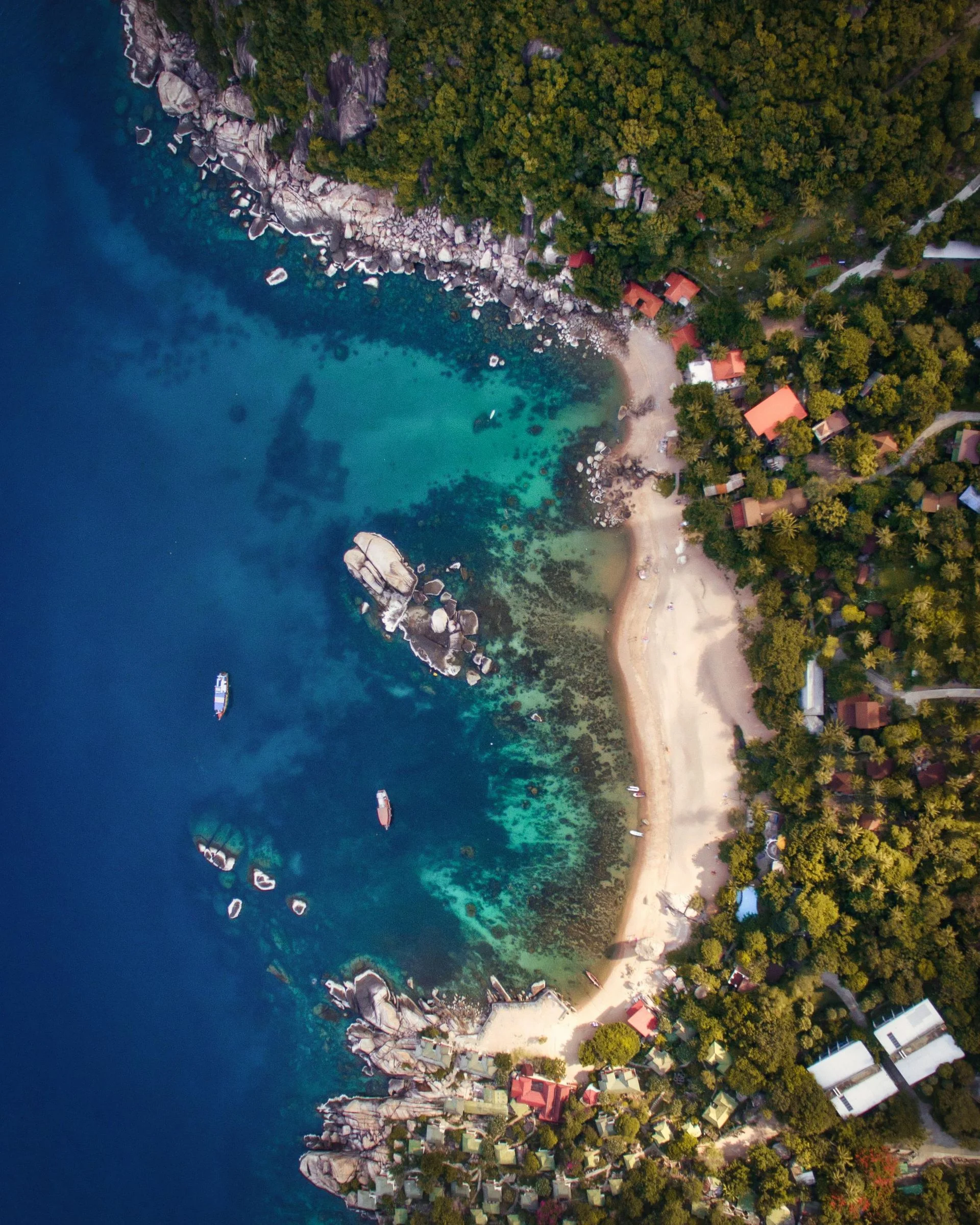
Koh Tao
Koh Tao — literally “Turtle Island” — is a compact jewel in the Gulf of Thailand that has become Asia’s mecca for learning to dive. Its sheltered bays and offshore pinnacles host a surprising variety of marine life: coral gardens alive with parrotfish and angelfish, rocky domes where barracuda and trevally swirl, and the occasional whale shark gliding in from the blue. Warm, clear water and a laid‑back island vibe make it ideal for beginners, but seasoned divers will still find thrills at deeper sites like Chumphon and Southwest Pinnacles.

Maldives
Scattered across the Indian Ocean like strings of pearls, the Maldives’ 26 atolls encompass more than a thousand low‑lying islands, reefs and sandbanks. Beneath the turquoise surface are channels (kandus), pinnacles (thilas) and lagoons where powerful ocean currents sweep past colourful coral gardens. This nutrient‑rich flow attracts manta rays, whale sharks, reef sharks, schooling jacks, barracudas and every reef fish imaginable. Liveaboards and resort dive centres explore sites such as Okobe Thila and Kandooma Thila in the central atolls, manta cleaning stations in Baa and Ari, and shark‑filled channels like Fuvahmulah in the deep south. Diving here ranges from tranquil coral slopes to adrenalin‑fuelled drifts through current‑swept passes, making the Maldives a true pelagic playground.

Hurghada
Hurghada is one of Egypt’s original Red Sea resorts and remains a popular base for day‑boat diving and liveaboard departures. Situated on the mainland’s eastern shore, the city offers easy access to a wide variety of reefs, wrecks and islands within a short boat ride. Warm, clear waters, gentle conditions and lively coral gardens make Hurghada ideal for training and fun diving, while nearby sites such as Abu Nuhas and the Thistlegorm wreck keep more experienced divers enthralled. Topside, the modern resort town boasts a lively promenade, international restaurants and plenty of après‑dive entertainment.

Great Barrier Reef
The Great Barrier Reef stretches for more than 2,300 km along Australia’s Queensland coast and is Earth’s largest coral ecosystem. With over 2,900 individual reefs, hundreds of islands, and a staggering diversity of marine life, it’s a bucket‑list destination for divers. Outer reef walls, coral gardens and pinnacles support potato cod, giant trevallies, reef sharks, sea turtles, manta rays and even visiting dwarf minke and humpback whales. Divers can explore historic wrecks like the SS Yongala, drift along the coral‑clad walls of Osprey Reef or mingle with friendly cod at Cod Hole. Whether you’re a beginner on a day trip from Cairns or an experienced diver on a remote liveaboard, the Great Barrier Reef offers unforgettable underwater adventures.

Sipadan & Semporna
Sipadan Island off the coast of Sabah is Malaysia’s crown jewel of diving – a steep limestone pinnacle rising more than 600 metres from the sea floor and teeming with pelagic life. Currents sweep past vertical walls encrusted in hard and soft corals, bringing in barracudas, jacks, reef sharks and bumphead parrotfish in breathtaking numbers. Nearby Mabul and Kapalai offer an entirely different experience on shallow sand‑slope reefs and artificial structures, where flamboyant cuttlefish, frogfish, mandarin fish and other macro critters hide among sponges and tyres. With limited daily permits, a visit to Sipadan is a privilege; most divers base themselves in the frontier town of Semporna or at water‑bungalow resorts on Mabul and Kapalai and make day trips into the park.